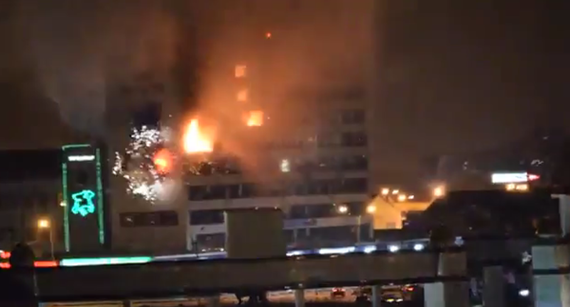It's 00:30 on December 4th 2014. Russia has invaded Chechnya again. Maybe. Reports say that Chechnyan rebels have killed some police officers. Six rebels, or maybe fifty, or maybe three hundred. Others are speculating that with the number of reported military vehicles it must be more, but the number of military vehicles is unconfirmed. Putin's motorcade has been spotted rushing to the Kremlin. Nobody is quite sure what is going on.
Chechnya has seen two wars with Russia in the last twenty years. Terrorist tactics, including hundreds of kidnappings and bombings that have claimed the lives of thousands of Russians. Moscow has responded with crushing military action including reprisal killings and bloody 'anti-terrorist' operations causing thousands of civilian casualties. It was Chechen rebels who seized a thousand hostages in a school in Beslan ten years ago: over 300 died in the rescue operation.
At present, the only news channel reporting the violence is a short note in Russia Today. It reports that three policemen have been shot dead by terrorists. The terrorists have fled to the Press House in the city centre. There is nothing coming out of Grozny through official channels, like a fog of war. Yet somehow I am in the thick of the action, watching images, videos and reportage from the centre of the city.
I am watching something on a webcam. The picture isn't very good, but I think it's a press office. I googled it and it looked about right. I think it's Grozny, the capital of Chechnya. I think there are tanks shooting it, which sounds like a thud, and maybe small arms fire. I think I'm watching a tank shell an office block on a webcam in Grozny, the capital of Chechnya.
The first Chechnyan War was twenty years ago. Twenty years ago, the internet was still an "information superhighway". News was official, through official sources, sometimes coloured by brave correspondents willing to put themselves in harm's way to bring us their story. No longer.
Information war has been a concept for years, and war propaganda for centuries, but its significance has been magnified by the rise of social media. This is the new face of conflict. Suddenly, we are all eyewitnesses, correspondents and propagandists. The first images pertaining to be from Grozny appeared in seconds. The first videos appeared within minutes. With Twitter's help, I've managed to find a live feed through a webcam, probably dangling from a window somewhere in a Chechen suburb. The picture is fuzzy, but the thud of tank fire is clearly audible. Whoever's webcam it is, they are my correspondent in Grozny, albeit temporarily: as I write this, there are reports coming from Vkontakte - Russia's biggest social media site - that mobile phone signal and phone lines are failing across Chechnya as the Russian military moves in. No matter, of course, as the locals are reportedly just moving to WhatsApp, so long as the internet stays up.

Grozny press office under fire, @vtchakarova
Twitter, and social media generally, gives a voice to everyone. The importance of social media in today's reportage and news sharing is higher than ever. Social media and the internet are now the primary tool we have in documenting and sharing the world around us. There are no budget constraints, no limits on manpower: if someone is there with a phone and an internet connection, what they are seeing is now recorded, probably permanently.
This is true of all major events now, of course. But war has a special power. It has always had its own rules when it comes to news reporting. Violence, conflict and war in the age of social media are going to be very different.
We are all correspondents. News is no longer the preserve of the journalist, who now frequently aggregates and colours material produced elsewhere, rather than producing first-hand reportage. It was odd, first time round, to see Sky News crediting Quince114 (Twitter) for its photo coverage, but has become commonplace now.
We are all eyewitnesses. Atrocities, war crimes and abuses of power have traditionally been shrouded in secrecy and frequently repressed. First-hand reportage has been dangerous and limited. In the past, interviews with the families and victims of injustice have tended to take place after the event. Now, violence can be documented and shared within seconds, colouring the way we fight more vividly than ever before.
We are all propagandists. Once limited to government communications, social media users are now on the front line in colouring their side of a conflict. The use of social media by the Islamic State is the best recent example. A tiny 'communications' body was capable of producing high-quality content and spreading it worldwide. Not only this, but we saw the emergence of 'hand-to-hand' propaganda, as fighters from both sides tweeted photos of enemy casualties back over the trenches.
There was just one thing that was a little unnerving about the messages on #Grozny. Having done some work following ISIS on Twitter over the past few months, I follow a few key accounts. As videos and photos began to stream out of the besieged city, messages of support and congratulations were being sent from Syria and Iraq, praising the 'mujahideen' responsible for 'shutting the whole of Russia down'. Twitter gives a voice to everyone.
